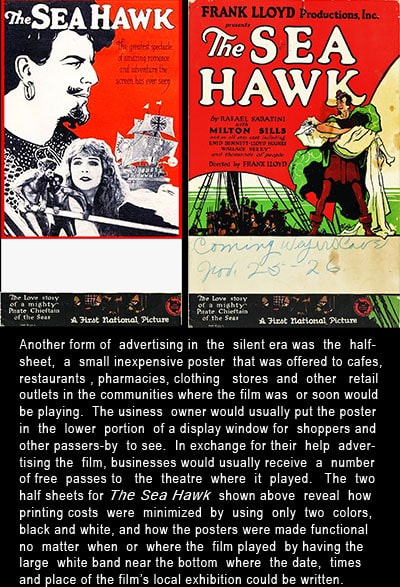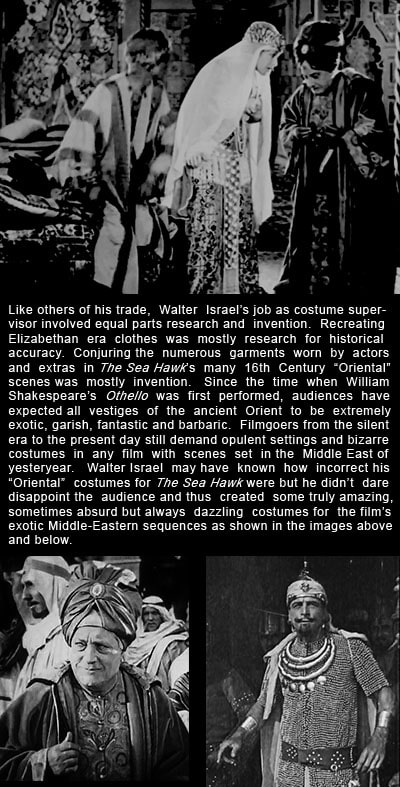THE SEA HAWK (1924)
Unlike the 1940 film of the same name, this version of The Sea Hawk is a faithful adaptation of Rafael Sabatini's popular 1915 novel. Set during the reign of Queen Elizabeth I of England, the plot is a rousing, sweeping historical melodrama rife with brotherly betrayal, mercenary seamen, cruel Spanish Galleon captains, galley slaves, Barbary pirates, Moroccan potentates and star-crossed lovers.
As expected, there are plenty of sequences aboard ships on the high seas and more than a few sea battles, but the story's most interesting--and most unusual for books and films of the early 20th Century--is the contrasting depictions of Western and Eastern cultures and religions wherein European standards and Christianity do not by any means prove themselves the moral superiors over "Oriental" (middle-eastern) society or the Muslim faith.
At the helm of this gigantic production was Frank Lloyd, who, according to the film's credits "personally supervised and directed" The Sea Hawk. Neither a novice director nor a stranger to historical pictures, Lloyd had by 1924 made well over forty feature films in nine years, including such costume dramas as David Garrick (1916), A Tale of Two Cities (1917), Les Miserables (1917), and Oliver Twist (1922). A year prior to directing The Sea Hawk, Lloyd made the sumptuous historical romance Ashes of Vengeance, starring Norma Talmadge (one of the revitalized silent classics found here on Sounds of Silents and available for viewing and downloading on the Internet Archive).
With his thorough knowledge of film making and his keen understanding of the moviegoing public, Lloyd realized that by 1924 audiences would not accept the use of model ships for the nautical sequences in a prestigious production such as The Sea Hawk. Thus, he insisted on using full-size replicas of the English, Spanish and Moroccan vessels in the film. However, the enormous cost of building the ships would inflate the budget and make it difficult, if not impossible, for the film to cover its cost, let alone earn a profit.
All of the nautical scenes in The Sea Hawk were shot off the shores of Santa Catalina, a small island approximately 30 miles off the coast of southern California. For the duration of filming here, over 100 tents were set up on the island for the cast, crew and more than 1,000 extras used in the big sea-battle scenes.
When casting the film roles in The Sea Hawk, Frank Lloyd neither took risks on unknown actors nor spent huge amounts of money for top stars. His cast was comprised of experienced, reliable actors, all well known to movie audiences but not top stars.
To play the main character, Sir Oliver Tressilian, an English gentleman-privateer who is captured at sea and made a galley slave aboard a Spanish galleon, escapes, converts to the Islamic religion and becomes a powerful Barbary pirate known as the Sea Hawk, Lloyd chose Milton Sills, an experienced stage and film actor whose dark, handsome face and strong, robust build had made him a matinee idol. The Sea Hawk marked the high point of Sills' career both in popularity and accolades--the film critic for The New York Daily News wrote "Mr. Sills is somewhat magnificent...in his alive and conquering role."
For Sills' leading lady in The Sea Hawk, director Frank Lloyd chose the lovely Australian actress Enid Bennett. Neither an ingénue nor a top star, Bennett at age 29 in 11924 had played leading roles in over two dozen films, most of them while under contract to Thomas H. Ince at the Triangle Film Corporation. Her greatest success prior to The Sea Hawk was in the role of Maid Marian, opposite Douglas Fairbanks, in the 1922 smash hit Robin Hood (one of the revitalized silent classics found here on Sounds of Silents at Blogger.com and available for viewing and downloading at the Internet Archive.net).).
Bennett remained a popular and highly regarded actress throughout the 1920's. She survived the transition to sound films and in 1931 played Jackie Cooper's mother in the sensationally popular film version of Percy Crosby's comic strip Skippy. The film received an Academy Award nomination for Best Picture and marked the high point of Bennett's talking-picture career. By choice, she worked less and less for the remainder of the decade and retired from the screen in 1941.
The Sea Hawk had many diverse supporting roles--English nobles, Moroccan spies, etc.--bu tthe three key secondary character parts were Lionel Tressilian, the half-brother who arranges Sir Oliver's kidnapping and deportation from England, Captain Jasper Leigh, the mercenary seaman whose cowardice causes Sir Oliver to become a galley slave aboard a Spanish galleon but later becomes Sir Oliver's trusted envoy and friend, and Asad-ed-Din, Basha of Algiers, who mentors Sir Oliver's career as a Barbary pirate.
Lloyd Hughes, who played the treacherous Lionel Tressilian, began acting in films in 1918 and, due to his clean-cut good looks, was soon working steadily playing minor or secondary roles. His break came in 1922 when he starred opposite Mary Pickford in the hit film Tess of the Storm Country. He then became a popular leading man and in 1924 alone appeared in eight films, including The Sea Hawk--one of very few times he was cast against type as the villain.
The turbaned, white-bearded Muslim mogul, Asad-ed-Din, was played by veteran stage and screen actor Frank Currier. After a highly successful career as a leading man on Broadway in the late Victorian and Edwardian eras, Currier began working in films in 1912 and soon became a busy character actor, much beloved by audiences for playing kindly or curmudgeonly grandfather roles. Despite the character of Asad-ed-Din being inherently ostentatious, Currier wisely underplayed the part. Whereas lesser actors would have been bombastic and extreme, Currier knew an all-powerful ruler who is also a strict adherent to the Islamic laws need not try to impress or threaten, and that quiet cunning is far more sinister.
Wallace Beery, one of the busiest, most versatile, highly regarded and enormously popular character actors of both the silent and the sound eras, played Captain Jasper Leigh with all the endearing crudeness for which he was already known and which would make him a world-famous top-ten box office star in the 1930's. The Sea Hawk was but one of eight feature films Beery appeared in during 1024. He is also the only actor to date who appears in three of the revitalized silent film classics found here at Sounds of Silents on Blogger.com, the others being Robin Hood and Ashes of Vengeance. No doubt, he will appear in still more of this site's collection of revitalized silent films in the future.
So grab a bag of popcorn and set sail over the bounding main as Sounds of Silents presents a GCM Production of a MaxManLA Video, The Sea Hawk, newly
revitalized with digital image enhancement, original title cards reproduction, a new opening credits sequence, a new intermission montage sequence and a synchronized symphonic music track.
The link below opens a page with FREE online viewing as well as several FREE downloading options made available by The Internet Ardhive.org.


















